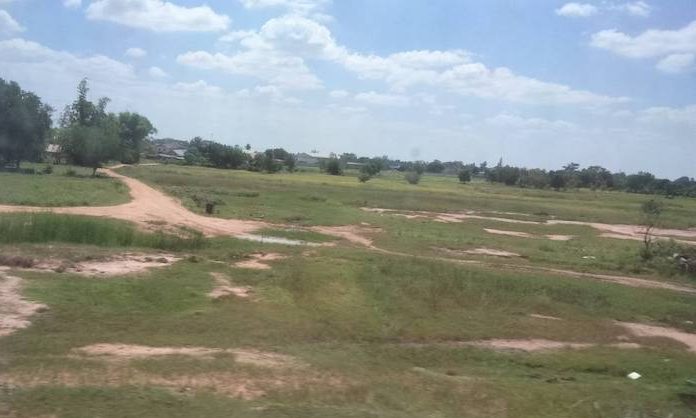The 450 kilometre drive by road from Khon Kaen to Bangkok (Thailand’s primate city) takes a full on, 6+ hours – complete with the dangers of sharing the journey with the usual moronic, kamikaze drivers, and then navigating Bangkok’s freeways.
A more relaxing way to get from the capital of Isaan to the capital of Thailand is by train. This service originates in Nong Khai.
- Timetable at Khon Kaen Station.
We booked two first-class tickets in person at the Khon Kaen Train Station, three days out from the trip. Be aware when booking that some seats face backwards to the direction of travel. Tickets are available online if you are able to navigate the execrable booking system.
On the day of departure the train was delayed an hour which didn’t seem to be a cause for comment for the thirty or so patrons waiting.
- MAP OF ROUTE – KHON KAEN TO BANGKOK
The carriages are air conditioned, the seats are comfortable and roomy, the windows are large (if a little dirty) and the staff are helpful.
- Roomy, comfortable carriages.
- Comfortable reclining seats.
Rail carriages are known as bogies in Thailand which can cause some confusion as this is the Western term for an under assembly of wheels and axles on which the carriage sits – generally two bogies per carriage.
The first impression of the train was that there was no ‘roll’ and not too much ‘clickety clack’.
Out of Khon Kaen, and for many kilometres after, the railway passes through farm land.
- Trackside farm.
- The railway runs through farmland.
The first station from Khon Kaen is Ban Phai, 43 kilometres south.
- Ban Phai Station
Road/rail interchanges are noticeable features. Most roads go under the railway and many of these underpasses were flooded. They would unusable for most of the rain season.
The second station from Khon Kaen is Mueang Phon and the third is Nong Bua Lai. Twelve kilometres further on, at Bua Yai Junction, the train line diverts west The other line heads south 70 kilometres to Korat.
Not far past this junction it’s time for lunch. Hot food in styrofoam containers must be pre-ordered – 50 baht.
- Food needs to b e pre-ordered.
- Local style food – 50 baht.
The scenery is still very rural.
- Still wet.
- Farm road.
- Another farm.
- Corn crop.
In the south-west of Chaiyapum Province the railway passes by a wind farm. It is one of a half dozen supposedly environmentally friendly sources of wind power in south-west Chaiyapum. The series of wind farms are generally aligned along the Phung Hoei Mountain Range, a rich wind resource.
- Part of a wind farm in south- west Chaiyapum.
- One of number of wind farms that stretch along the line of the Phung Hoei Mountain Range.
Ban Luam, the fifth stop, has no platform.
- Ban Luam Station.
- Ban Luam Station.
Similarly, Chatturat Station has no platform and railway staff put temporary steps in place to allow passengers access/egress. The next stop is a pretty little station – Bamnet Narong.
Next is the old and small Ban Wa Tabaek station, followed by Lam Narai, a small station. The views are still rural.
- More farm land.
- Corn crop.
The railway follows the western edge of Pasak Chonlasit Dam and in three places is routed over water. This is the much touted ‘floating railway’.
- Island in the reservoir.
- Southern edge of the rail/water interface.
Not far after Chonlasit is the small Kaeng Sue Ten station.
As the train pulls into Kaeng Khoi Junction the surrounds are noticeably starting to get more metropolitan.
Next station is Sara Buri, then Ban Phachi Junction.
- Junction.
Ayutthaya, ancient capital of Siam, is the next stop but the train doesn’t stop at the next station, Chiang Rak.
The views are definitely more metropolitan as the stations pass by – Rangsit and then Don Mueang, right next to the airport.
- The arrival at Bangkok’s station doesn’t do justice to one of the world’s greatest cities.
We detrained at Krung Thep Amphiwat Central, the terminus of the journey.
© Kim Epton 2023
701 words, 27 photographs, one image.
Feel free to use any part of this document but please do the right thing and give attribution to adventures.net.au. It will enhance the SEO of your website/blog and Adventures.
See Terms of Use.




























